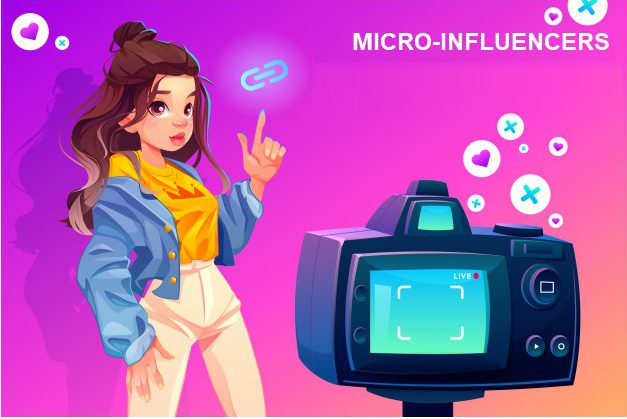The Power of Micro-Influencers: Why Smaller Influencers Can Make a Big Impact on Influencer Marketing

The Power of Micro-Influencers: Why Smaller Influencers Can Make a Big Impact on Influencer Marketing
In recent years, the world of influencer marketing has seen a significant shift towards Micro-Influencers. These individuals have a smaller following than the more prominent Influencers, but they have a more engaged and loyal audience. Brands are starting to realize Micro-influencers' potential and are increasingly partnering to reach their target audience. This article will discuss why Social Media-Influencers are becoming more popular and why they can make a big impact.
What are Micro-Influencers?
Micro-Influencers are social media users with between 1,000 and 100,000 followers on their social media platforms. They are often regular people who have built a loyal following through their niche content, such as food, fitness, or beauty. These Influencers have a more personal connection with their followers, and their content is often seen as more authentic and relatable. This makes them ideal for brands that want to connect with a specific audience, as they have a more engaged and targeted following.
The Rise of Micro-Influencers
The rise of Micro-Influencers can be attributed to several factors. Firstly, The digital platform-Influencers are often more affordable than their larger counterparts. This makes them an attractive option for small and medium-sized businesses with limited marketing budgets. For example, a micro-influencer with 10,000 followers may charge $500 per sponsored post, whereas a macro-influencer with 1 million followers may charge $10,000 or more for the same post.
Secondly, Micro-Influencers have higher engagement rates compared to larger Influencers. This is because their followers are more invested in their content and often have a personal connection with them. According to a study by Markerly, Influencers with 10,000 to 100,000 followers have an average engagement rate of 2.4%, compared to 1.7% for Influencers with 100,000 to 1 million followers and 1.1% for Influencers with over 1 million followers.

The Impact of Micro-Influencers
Despite their smaller following, Micro-Influencers can make a big impact on brands. Here are some reasons why:
-
Authenticity: these Influencers are often seen as more authentic and relatable than larger Influencers. This is because they connect more with their followers and often share their experiences and opinions. This makes their content more genuine and trustworthy, leading to higher brand engagement and conversions.
-
Niche Audience: Micro-Influencers often have a niche audience that is highly engaged and interested in their content. This makes them ideal for brands that want to reach a specific audience, such as vegans, fitness enthusiasts, or beauty lovers. By partnering with these Influencers, brands can tap into their audience and reach potential customers more likely to be interested in their products or services.
-
Cost-Effective: Micro-Influencers are often more affordable than larger Influencers, making them a cost-effective option for brands. This is particularly beneficial for small and medium-sized businesses with limited marketing budgets. By partnering with Micro-Influencers, they can reach their target audience without breaking the bank.
-
Higher Engagement: As mentioned earlier, Micro-Influencers have higher engagement rates than larger Influencers. This means their followers are more invested in their content and more likely to engage with sponsored posts. This can lead to higher click-through rates, conversions, and sales for brands.
-
Long-Term Relationships: The digital platform-Influencers are often open to building long-term brand relationships. This can be beneficial for both parties, as it allows the influencer to establish themselves as a trusted brand ambassador and the brand to maintain a consistent presence among their target audience. Long-term partnerships also allow Influencers to create more in-depth content that showcases the brand's products or services.
-
Creative Content: Micro-Influencers often have unique styles and approaches to creating content. This can help brands stand out and differentiate themselves from their competitors. Social Media-Influencers are also more likely to experiment with different types of content, such as Instagram stories, IGTV videos, and TikTok videos, which can help brands reach a wider audience.
-
Trust: Micro-Influencers often have a higher level of trust among their followers than larger Influencers. This is because they are seen as more authentic and relatable, and their followers feel that they have a personal connection with them. This trust can transfer to brands that partner with Social Media Influencers, as their followers are more likely to view the brand as trustworthy and reliable.
How to Work with Micro-Influencers

Working with Micro-Influencers requires a different approach compared to larger Influencers. Here are some tips for brands that want to collaborate with Micro-Influencers:
-
Find the Right Fit: When searching for Micro-Influencers to collaborate with, finding ones that align with your brand's values and target audience is important. Look for Influencers that create content relevant to your brand and that resonates with your target audience.
-
Personalize Your Outreach: When reaching out to Micro-Influencers, avoid using generic messages or templates. Take the time to personalize your outreach and show that you have researched their content and audience. This will help you build a relationship with the influencer and increase the likelihood of a successful collaboration.
-
Provide Clear Guidelines: When working with Micro-Influencers, it's important to provide clear guidelines for their content. This includes details on the product or service being promoted, any specific messaging that must be included, and any requirements for visual elements such as photos or videos.
-
Build Relationships: Building relationships with Micro-Influencers can lead to long-term partnerships and a more authentic connection with their audience. Take the time to get to know the influencer, engage with their content, and provide feedback on their sponsored posts.
-
Measure Results: To determine the success of your micro-influencer campaign, it's important to measure the results. This includes tracking engagement rates, click-through rates, conversions, and sales. Use this data to optimize your future campaigns and identify which Influencers are the most effective for your brand.
Conclusion
Micro-Influencers are becoming increasingly popular in influencer marketing, and for a good reason. They have a more engaged and loyal audience, and their content is often seen as more authentic and relatable. For brands, partnering with these influencers can lead to higher engagement, conversions, and sales while being more cost-effective than with larger Influencers. Following the tips outlined in this article, brands can successfully collaborate with Micro-Influencers and tap into their niche audience. As the world of social media continues to evolve, it's clear that Influencers will continue to play an important role in the world of influencer marketing.
Using Self-serve influencer marketing platforms such as Viralpitch has made it easier for brands to discover and collaborate with these Influencers. This platform allows brands to search for digital platform Influencers by niche, location, and follower count, making it easier to find the right Influencers for their campaign.
